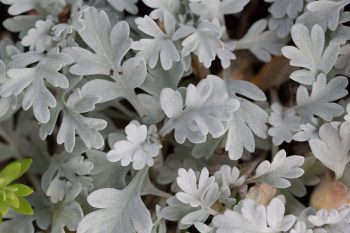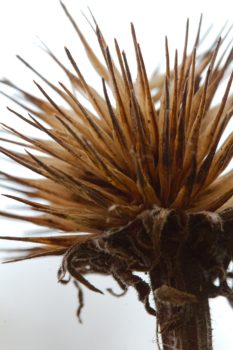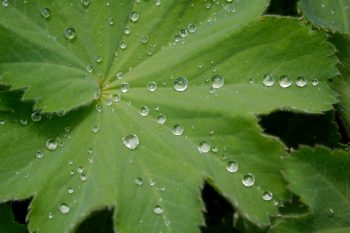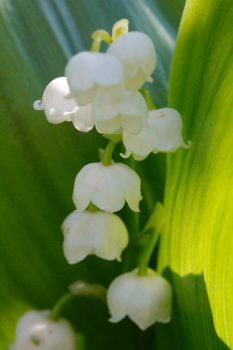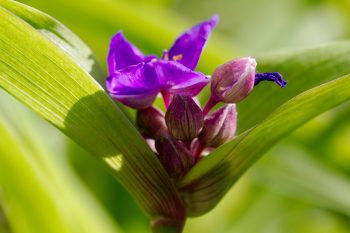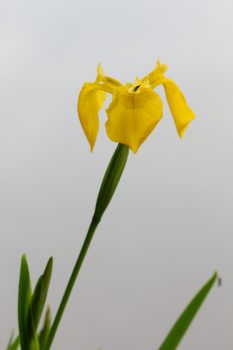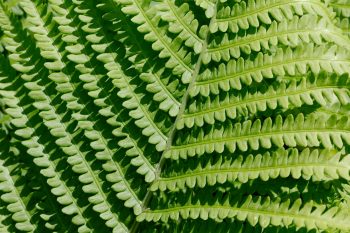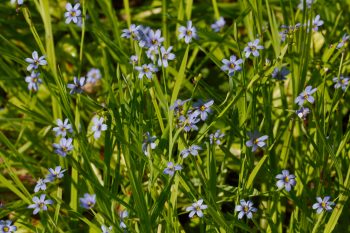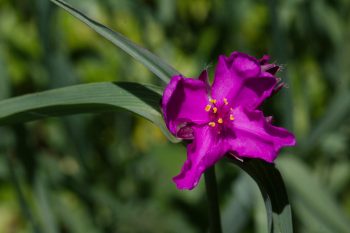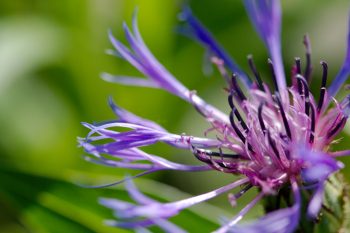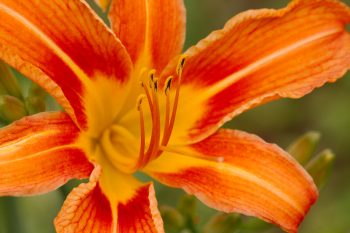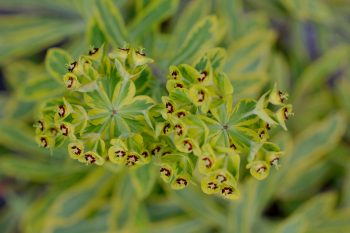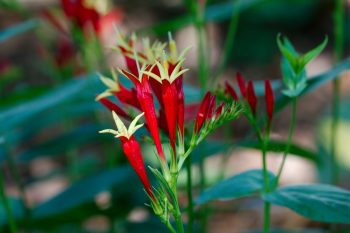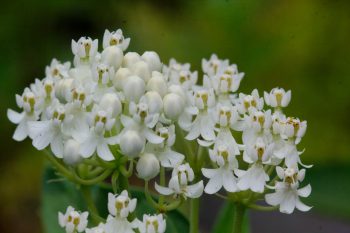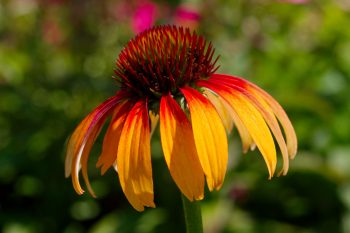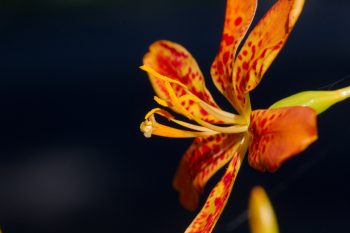Dusty Miller (Jacobaea maritima, a.k.a. Senecio cineraria) is a marginally hardy, herbaceous perennial. It’s hardy here, anyway. We have it growing in an urn-shaped container near the end of our driveway and it seems happy enough. It does have flowers but they are not particularly ornamental and many people prune them off so as not to distract from the foliage, which is what the plant is generally grown for. It does well in both shade and sun and really takes very little care.
Tagged With: Hardy Perennial
Dusty Miller
Echinacea purpurea
This is purple coneflower (Echinacea purpurea) although obviously there isn’t any purple color here right now. These are last year’s seeds, which we generally leave up all winter for the birds. They are obviously well fed, because by spring, most of them are still here. It’s just about time we cleared them all out. Most of the black-eyed Susan seed stalks have been cleared, although we’ve left some yet.
I was on the ground taking photos of a columbine (Aquilegia) and happened to notice this coneflower stem next to me, so I rolled over on my back and took a few shots, hoping to get a little detail in the seeds, which were seriously back-lit by the sky. This one turned out pretty well. I would have liked to get a little further away, as well, but I was looking nearly straight up and getting further away would have required that I dig a hole to get into. So, not going to happen.
Alchemilla mollis ‘Auslese’
It’s a week early for Mother’s Day but we’ve been cooped up for too long and we didn’t want to wait until next week. We took our annual trip to Fehr’s Nursery early this afternoon and Cathy bought a load of plants. As usual, I wandered around and took photos of flowers, etc. I got some nice pictures of various hens and chicks (Sempervivum varieties) including some Sempervivum arachnoideum, which have what look like cobwebs on them. I decided to go with this photo, however, of lady’s mantle leaf (Alchemilla mollis ‘Auslese’) with water droplets on it.
White Flowering Clematis
In the back of our garden, near the fence where there was a huge rose bush, there is a clematis. For years it’s struggled to be seen among the rose, which was often out of control. Well, the rose is gone now, having mysteriously died last year. I’m sad about that, and wish it hadn’t died but at least this beautiful, white clematis is still there and is doing quite well, now that it’s getting the sun it needs and isn’t overshadowed by the huge plant. We will need something for it to clime on but for now, it’s just happy to be blooming in the sun.
Uvularia perfoliata (Perfoliate Bellwort)
It was quite cool this morning after a soft freeze over night. There was ice in both bird baths this morning, not just the pedestal meaning it got pretty cold. I had covered my recently planted camellias and we moved some pots into the garage, so everything seems fine. We went for a very nice walk in Rock Creek this afternoon and saw lots of pretty things, including this perfoliate bellwort (Uvularia perfoliata), a pretty little wildflower we don’t see very often. The word ‘perfoliate’ means the base of the leaf surrounds or is pierced by the stem.
Lily of the Valley (Convallaria majalis)
I know I’ve already had a picture this spring of the lily of the valley (Convallaria majalis) from our garden but it’s blooming so well and so long that I thought I’d share another. We’re also in a little lull where there isn’t a lot new coming out, although it’s still changing. So, here’s another view of the little white bells of the lily of the valley, this time from the back garden, near the fence (not that it makes much difference, of course). Soon the flowers will be gone and even the leaves will fade in the coming heat of summer. We are near the southern limit of where it grows well. If you grow it here, it needs some shade to protect it from the heat of the summer sun but further north it does well in full sun.
We also have a terrific crop of Canadian thistle (Cirsium arvense) coming up among it (and many other places, as well) and it really needs to be dealt with. That’s a really problematical weed, having “a deep and wide-spreading root system with a slender taproot and far-creeping lateral roots.” (Source: Fire Effects Information System, US Forest Service). That same document also says that “new plants can also form from root fragments as short as 0.2 inch (6 mm),” which helps explain why it’s so hard to get rid of.
Tradescantia virginiana (Spiderwort)
One of our favorite herbaceous perennials is the spiderwort (Tradescantia virginiana). It’s a native and is easily grown in our gardens. In addition to the ‘standard’ versions, we have a few named varieties. This is one of the plain species and it’s lovely, of course. This one is right outside our back door and this is the first bloom of the year. I’ll almost certainly return to it later, when it has more flowers, or will post a photo of one of the other, slightly more exotic varieties. But they really don’t need much improving.
Iris pseudacorus, (Yellow Flag)
I took pictures in the yard earlier today but then Cathy and I went to Meadowside Nature Center and took a walk there. Since most of my pictures this spring have been from the yard, I decided to feature a photo from off-site today. We walked from the nature center down to the creek (North Branch Rock Creek) and from there to the lake. We could see the eagle’s nest and at one point saw one of the juvenile eagles sitting on the edge of it. We stopped and sat by the edge of Lake Frank and I took some photos of these yellow flags (Iris pseudacorus), growing on the shore. They are native to Europe and western Siberia, the Caucasus, and northern Africa. They’re quite lovely and I particularly liked the way these were shown against the grey of the very still water. We enjoyed watching the swifts or swallows skimming around over the lake. We heard a barred owl a few times in the distance.
Woodwardia Frond
I’ve had a few fern photos this spring but here’s another. This is a Woodwardia of some type but I’m not sure which. It’s growing in our shade garden at the north end of our front yard and is quite happy there. We went to the garden center today and I bought a royal fern (Osmunda regalis) to plant in this part of the garden. My thought is to move the Japanese painted fern (Athyrium niponicum var. pictum) to the front of the bed, because it’s too short to be seen well where it is. The royal fern should be plenty tall so that will be nice. It’s something I’ve wanted a while.
Peony ‘Coral Sunset’
In the fall of 2014 I planted three of these peonies, called ‘Coral Sunset’, in our back garden. They have bloomed a bit better each year and I really look forward to seeing them each year. Between the three plants there are seven blooms this year and they are wonderful. There are a lot of peonies I’d be happy to have but I think this one is high on my list. The stems are strong and the flowers not so heavy that they all droop down, which means you really get the full effect of the blooms. Interestingly, they fade to a pale almost-yellow color as they age, which isn’t nearly as striking, but I’m not about to complain.
Sisyrinchium angustifolium (Blue-eyed Grass)
There is a lot of interest in native plants and in general I don’t mind that. They often thrive in out local conditions. It’s somewhat related to the emphasis on so-called organics (as opposed to synthetics), thinking that they are inherently better and safer. Nevertheless, some natives can easily become weeds. Blue-eyed grass (Sisyrinchium angustifolium) is a case in point. It’s actually lovely and in its place, worth growing. But be aware that it will come up around your yard and garden and if you don’t want it to take over, you’ll need to be a little ruthless in pulling it out.
Allium moly (Golden Garlic)
I really should plant more of this as well as other ornamental onions. This is Allium moly, often called golden garlic, and it’s a lovely little bulb, blooming later than many of the spring bulbs. Its flowers are smaller than daffodils but it makes up for that by being one of the few things in bloom right now. In theory it spreads and needs to be controlled when growing in ideal conditions. Clearly that’s not what it has here, but it seems happy enough. Another Allium that I’ve had but don’t now is Allium caeruleum, which has pale blue flowers. I think I’ll order some of that, too, this fall, along with a bunch more deffodils.
Pink Spiderwort
We have two of these pink spiderworts in the side garden. They really are nice and I took some photos today with this one in the foreground and with the more usual blue flowered variety being it. We don’t remember the name of this variety and it may be a type of Tradescantia ohiensis, the Ohio spiderwort, rather than T. virginiana. There are others, too, of course. Anyway, it’s a really nice flower and lovely in the border. The flowers open in the morning and then close up during the heat of the day, so best appreciated early. This was taken from about the same spot as yesterday’s photo of the wren.
Mountain Bluet (Centaurea montana)
The mountain bluet (Centaurea montana), also known as perennial cornflower or perennial bachelor’s button, has a pretty, blue flower and does well in the perennial border. Dorothy and three of her housemates drove down late yesterday and today we took a drive out to Rocklands Farm Winery. They have just reopened and it was really nice to be out. Actually, we spent most of our time there visiting with Greg and Janis, which I really enjoyed. This flower is in Janis’ garden and I took it as we ate our lunches and got caught up with what everyone is doing. For information on Rocklands, see https://www.rocklandsfarmmd.com/.
Day Lily
The day lilies are starting to bloom. These are descendants from some we dug up in the woods of Pennsylvania, near our property. They are growing around what used to be a homestead, many years ago. There is a hole in the ground with the remains of stone walls and the base of a chimney. Around that are orange day lilies (Hemerocallis fulva) and periwinkle (Vinca minor) growing in great profusion. It’s in the shade as trees have grown up over it and in consequence the day lilies don’t bloom as well as they might, but we took a few home and planted them in the sun, where they bloomed quite happily. That was at our old house and we dug up and brought some of those with us here, where they continue to give a great show every year.
Euphorbia amygdaloides subsp. robbiae (Wood Spurge)
I took a few more pictures of plants on Cathy’s work table today. This one is a spurge called Euphorbia amygdaloides subsp. robbiae, also known as Robb’s wood spurge. It’s a nice combination of greens and yellows and something nice for the herbaceous border. The Euphorbia genus has something like 2,000 species and they range from small annual plants to trees and there are species from many parts of the world This one isn’t native to North America, but I’m not bothered by that. One thing you want to be careful of with these plants is their milky sap, which is poisonous if ingested and a skin irritant.
Spigelia marilandica (Indian Pink)
Here’s a second photo for the day. After our walk in the park, we went to the Agricultural Farm Park and walked through their demonstration garden. It’s really changed since we were here last, about two months ago. There was one plant in bloom that really caught our collective eye. It’s a Maryland native commonly called Indian pink (Spigelia marilandica). What a beautiful flower. This is something I’d really like to get. I’ve done some searching and it seems like finding seeds will be difficult. There are a few mail order places that have the plant but most of them ship in the fall. Hopefully I’ll remember to order some then.
Asclepias incarnata ‘Ice Ballet’
We’re big fans of Asclepias and have three species growing in our garden. We have a few varieties of Asclepias curassavica, a tender perennial native to the Caribbean and Central and South America often referred to as blood flower. We have several Asclepias tuberosa, butterfly weed, a hardy perennial native to our region. We just bought a few plants of a variety of Asclepias incarnata called ‘Ice Ballet’. The species is generally pale pink but this variety is a creamy white. It’s also a native to the area and is known as swamp milkweed. These will go in a spot that gets very wet when it rains, as these don’t mind that and there are a lot of things that won’t grow there.
‘Fiery Meadow Mama’ Coneflower
I could see a fairly large garden with nothing but varieties of coneflower (Echinacea species and varieties). One problem we have with them is that the rabbits and deer seem to like them and many that come up have their flowering stem bitten off so we don’t get flowers on them. The few that do bloom are great, of course, but then th bugs get to them and the petals get holes in them. They’re still nice, but not as photogenic. Because of that, we hesitate to buy more coneflowers. This one, called ‘Fiery Meadow Mama’, nearly made me make an exception. Wow, what a flower. There was another called ‘Cone-fections Hot Papaya’ that was mostly red and with a larger center that was nice, too. But we restrained ourselves.
Iris domestica (Blackberry Lily)
The blackberry lily (Iris domestica, formerly known as Belamcanda chinensis, has beautiful, bright orange flowers above an attractive fan of sword-shaped leaves. It spreads slowly into clumps but mostly spreads by seed, which are distributed both by birds and by wives who really like it in our garden. I first collected seeds in South Carolina many, many years ago and we’ve had it around ever since. We have quite a few at this point and we may be reaching the time when a few of them need to be pulled up (but I’m not sure Cathy’s ready for that yet). They are native from the Himalayas to the Russian far east but do very well here. I like the lighting in this. The bloom is in full sun and the background is the pavement of our street in shadow.

